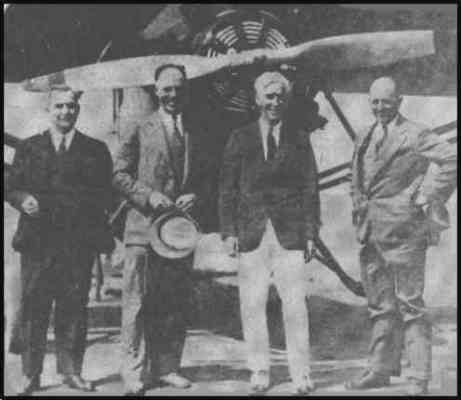

|
|
Left to Right: E. F. Roberts, vice president, in charge of production, Packard Motor Car Co.; Capt. L. M. Woolson, designer of plane;
Gar Wood, designer of speed boats and Walter E. Lees, chief test pilot and aeronautical service engineer for the Packard Motor Car
Co.
From Detroit at Cost of $8.50 Packard Motor Will Get Further Tests at Miami, Pilots Say After a non-stop flight from Detroit to Miami Sunday in 10 hours and 15 minutes on which but $8.50 worth of fuel was used instead of gasoline, Capt. L. M. Woolson, Detroit pilot who, with Walter E. Lees, co-pilot, flew the plane to Miami, said he would continue tests of the new Packard Diesel aircraft engine, which made the economical flight possible. "We had the plane wide open on the trip down and used only 13 or 14 gallons of oil," he said, "but if we had been using gasoline, it would have cost us for fuel about $4.20 an hour. Although the engine was given only a casual inspection before the trip and is the same one put through a 50-hour government test about two weeks ago, we had absolutely no trouble with it." Captain Woolson said no passengers would be carried during the tests here, inasmuch as the engine is still in the experimental stages and ha not been issued the department of commerce approved type certificate, but that it would be flown during his week's stay here in test flights. "There is no danger from fires with the new engine," he said, "because the fuel won't burn unless it is vaporized, and the ignitiion is from high-compression and so there is no electrical wires to short circuit. The absence of an electrical ignition system also does away with interference with radio receptivity, which commonly is the case on the planes using gasoline engines. There is no carburetor to get out of order and no spark plugs to foul." The economy in fuel use also gives the plane a wider cruising range, Captain Woolson pointed out. The cylinders work independently and each is force fed, so that if one fails, the others continue working. Another advantage in the engine, he says, is the weight, for which it develops 225 horsepower and is capable of 1,900 revolutions per minute, it is 2.26 pounds lighter per horsepower that any gasoline engine under 200 horsepower. Life of the fuel is yet undetermined, he said, but one of its type has been subjected to a 500-hour test with a dynamometer, and the maintenance has been found to be less than a gasoline engine. The cost of manufacture is approximately the same as that of a gasoline engine. Ignition of the fuel is by compressed air which, under a pressure of 550 pounds to the square inch, fires the atomized oil at 1,000 degrees Fahrenheit. Unless broken up into atoms, the oil will not ignite, but instead will put out the blaze just as water does. Captain Woolson said he and Mr. Lees are in Miami for a week's vacation, but brought the plane with them to continue their tests. They are to return to Detroit in it at the conclusion of their stay. The pilots are stoppng at the Columbus hotel. 

|